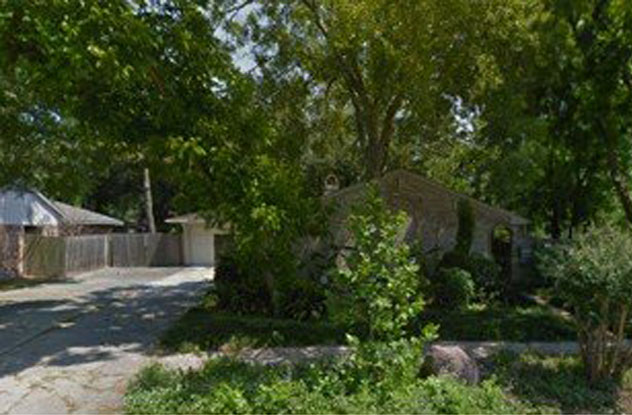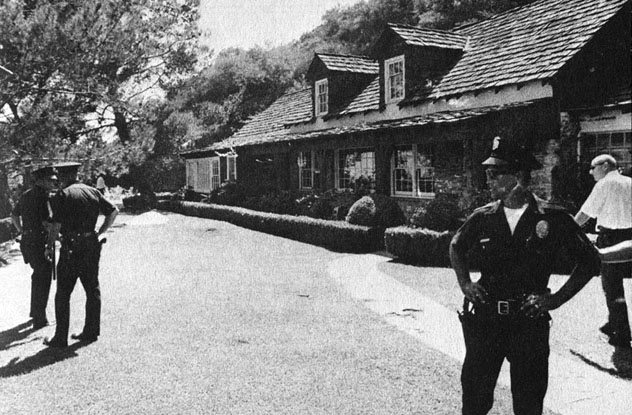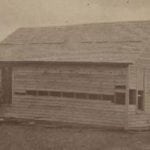 Weird Stuff
Weird Stuff  Weird Stuff
Weird Stuff  Our World
Our World 10 Ways Your Christmas Tree Is More Lit Than You Think
 Movies and TV
Movies and TV The 10 Coolest Stars to Set Sail on The Love Boat
 History
History 10 Things You Didn’t Know About the American National Anthem
 Technology
Technology Top 10 Everyday Tech Buzzwords That Hide a Darker Past
 Humans
Humans 10 Everyday Human Behaviors That Are Actually Survival Instincts
 Animals
Animals 10 Animals That Humiliated and Harmed Historical Leaders
 History
History 10 Most Influential Protests in Modern History
 Creepy
Creepy 10 More Representations of Death from Myth, Legend, and Folktale
 Technology
Technology 10 Scientific Breakthroughs of 2025 That’ll Change Everything
 Weird Stuff
Weird Stuff Ten Bizarre Facts About The Doge Meme
 Our World
Our World 10 Ways Your Christmas Tree Is More Lit Than You Think
 Movies and TV
Movies and TV The 10 Coolest Stars to Set Sail on The Love Boat
Who's Behind Listverse?

Jamie Frater
Head Editor
Jamie founded Listverse due to an insatiable desire to share fascinating, obscure, and bizarre facts. He has been a guest speaker on numerous national radio and television stations and is a five time published author.
More About Us History
History 10 Things You Didn’t Know About the American National Anthem
 Technology
Technology Top 10 Everyday Tech Buzzwords That Hide a Darker Past
 Humans
Humans 10 Everyday Human Behaviors That Are Actually Survival Instincts
 Animals
Animals 10 Animals That Humiliated and Harmed Historical Leaders
 History
History 10 Most Influential Protests in Modern History
 Creepy
Creepy 10 More Representations of Death from Myth, Legend, and Folktale
 Technology
Technology 10 Scientific Breakthroughs of 2025 That’ll Change Everything
10 Infamous And Terrifying Houses Of Murder
Nearly everyone is familiar with the Amityville Horror house, where 23-year-old Ronald DeFeo killed his parents and four younger siblings. Even more terrifying was the “Murder Castle” of H.H. Holmes, a hotel built for Chicago’s World’s Fair of 1893. Here, among a warren of hidden passageways and windowless rooms, he murdered an untold number of guests.
Every house has a legacy, but if the walls could talk in the houses listed below, they would scream.
10Fox Hollow Farm
Westfield, Indiana
Despite racking up a considerable number of victims, serial killer Herb Baumeister isn’t what you might call a household name, probably because he committed suicide as investigators closed in. Despite a diagnosis of schizophrenia and a history of bizarre behavior, Baumeister founded a chain of thrift stores and became quite wealthy. He purchased a sprawling, 18-acre estate outside Indianapolis, Indiana called Fox Hollow Farm.
It was here that he perpetrated much of his carnage, picking up young men at gay bars and bringing them home to meet their doom. When authorities searched Fox Hollow Farm, they discovered the remains of 11 men, mostly charred bone fragments. He would later be linked to several other unsolved murders, committed while he was on “business trips.”
Horrified by what her husband had done, Julie Baumeister moved her three children out of the home. The property stood empty for years, plagued by its fiendish legacy.
The estate was purchased by Rob and Vicki Graves, who claimed to see the dismembered ghosts of Baumeister’s victims. They even discovered more bones on the property. A tenant who lived in an apartment on the farm actually claimed to have encountered the spirit of Herb Baumeister himself, even supposedly recording his voice.
9The Cleveland Strangler Murder House
12205 Imperial Avenue, Cleveland, Ohio
Anthony Sowell’s criminally violent behavior appeared from an early age. He raped his niece when he was just 11 years old. He went on to have a decorated career in the US Marine Corps, but shortly after returning to civilian life, he assaulted a female visitor to his home. The offense earned him 15 years in prison for attempted rape.
Upon his release in 2005, he got up to the same old tricks. For a couple years, he dated Lori Frazier, the niece of Cleveland’s mayor. Frazier would later claim that she’d smelled putrid odors at the house, which Sowell variously blamed on his stepmother (who also lived at the house) and a nearby sausage factory. In September 2009, Sowell attacked and raped a woman at his home. She reported it to the police, who came to the house on October 29. The Cleveland Strangler wasn’t home, but they discovered two corpses in the living room.
Sowell was arrested two days later. Between the house and the backyard, the remains of 11 women were found. Unfortunately for those in the mood to go sightseeing at Anthony Sowell’s house of horrors, the city elected to demolish it to respect the memory of the victims. Sowell himself languishes on death row.
8Conrad Aiken House
228 E. Oglethorpe Avenue, Savannah, Georgia
The red brick row house was built in 1842. Pulitzer Prize winner Conrad Aiken’s family, originally from New England, moved to Savannah, where his father became a prominent surgeon. The family was wealthy and respected, but his father was mentally ill and exhibited strange behavior which culminated on February 27, 1901. Conrad, just 11 at the time, heard his parents arguing about money then heard gunshots. He investigated and found his parents’ bodies—his father had shot his wife before turning the gun on himself.
Conrad and his siblings were sent to live with relatives. Many years later, he came back to Savannah and actually purchased the house next door to the one where his parents died. He was a frequent visitor to Bonaventure Cemetery, where they were buried.
Aiken died in 1973 at age 84. Today, the house is owned by Dr. Jackson Morgan, who allowed paranormal investigators to explore the property. They recorded a series of eerie floating orbs and voices, suggesting that the Aikens may still indeed dwell on Oglethorpe Avenue.
7Glensheen Mansion
3300 London Road, Duluth, Minnesota
Glensheen is a beautiful Jacobean mansion overlooking Lake Superior. It was built in 1905 by Chester Congdon, who’d made a vast fortune in the mining industry. When Congdon and his wife died, the property went to their daughter Elisabeth, who adopted two children, Marjorie and Jennifer. Marjorie was a problem child, diagnosed as a sociopath early in life. She had seven children and drifted between men, mooching off them or off her mother.
In a crime scene that seemed as if it were taken directly from a Clue board game, Elisabeth Congdon and her nurse Velma Pietila were found dead in one of the mansion’s bedrooms. Congdon had been smothered with a pillow and Pietila had been bludgeoned with a candlestick.
Suspicion immediately fell on Marjorie (who stood to inherit some $8 million upon her mother’s passing) and on her second husband, Roger Caldwell. Roger was convicted of the murder in 1978, but Marjorie was inexplicably acquitted.
Caldwell was released after just five years. Shortly thereafter, he committed suicide, leaving a note proclaiming his innocence. In the years since, Marjorie has been linked to crimes from arson to bigamy and has been suspected of being involved in at least two murders.
Today, the 39-room Glensheen Historic Estate is owned by the University of Minnesota and is operated as a museum. It’s even a wedding destination. For many years, guides were instructed to gloss over the brutal specifics of the murders, but these days, they are open to discussing them.
6Andrea Yates’s House
942 Beachcomber Lane, Houston, Texas

We often derive our greatest comfort and love from our mothers, so when we hear of a woman killing her own children, something primitive and horrible stirs in us. On June 20, 2001, Andrea Yates, a woman with a dark history of mental illness, drowned all five of her children (aged six months to seven years) in the bathtub of her home in Houston, Texas.
A house with such an ugly past could conceivably sit empty for decades; few people would want to live in any murder house, much less one where five innocent children lost their lives. But just three years later, the pretty house sold for $87,000. The new owner, Peter Muller, said, “It’s in a good location. Plus, it’s got a great layout. There’s a living area and combined dining area.”
The curious still drive past for a glimpse. When asked, Muller said, “I don’t really care about [the home’s] history . . . It doesn’t really bother me.”
5Kreischer Mansion
4500 Arthur Kill Road, Staten Island, New York
Kreischer Mansion is easily the creepiest-looking residence on this list, a rambling, giant Victorian complete with a turret. The mansion was built in 1885 for Edward Kreischer by his father, a German brick maker. By 1894, the family business was in steep decline. Distraught, Edward shot himself in the head at his home.
This in and of itself would be an ugly stain on the property, but Edward Kreischer’s suicide was far less chilling than an event that happened over a century later. In 2005, the mansion’s caretaker, Joseph Young, murdered a man named Robert McKelvey on the orders of the Bonnano crime family. He initially attempted to strangle McKelvey, but the victim broke away. So Young caught up with McKelvey, stabbed him, and drowned him in a pool. He then chopped the corpse to pieces with a hacksaw and burned them in the mansion’s furnace. Young was sentenced to life in prison.
Kreischer Mansion is said to be swarming with ghosts. The most vocal seems to be Kreischer’s widow, who can be heard weeping in grief. Unlike many of the other houses on the list, which are either occupied or destroyed, this mansion is currently on the market for around $1.5 million.
4Mercer Williams House
429 Bull Street, Savannah, Georgia
The beautiful Mercer Williams house was built between 1860 and 1868, with construction stalled while the Civil War raged. It changed hands several times, and it served as a Shriners Temple. At least two people died in accidents at the property, including a young boy who fell off the roof and was impaled on an iron railing.
The house was empty until 1969, when it was purchased by Jim Williams, a young preservationist and antiques dealer. It took two years to return the property to its former splendor. Williams was known for throwing huge, elaborate parties, a tradition which went on until 1981, when Jim shot his assistant.
Williams claimed he’d acted in self-defense against 21-year-old Danny Hansford, but he was charged with murder. During the trial, it emerged that the two men had been having an affair. Williams endured four trials over the course of eight years before he was finally acquitted. Rumor says a voodoo pact helped assure his freedom.
Upon his release, Williams returned to his famous parties, but he did not have long to celebrate. He died of complications from pneumonia eight months later. His body was supposedly discovered in the exact spot he would have fallen had Danny Hansford shot him.
This story is retold in John Berendt’s novel Midnight in the Garden of Good and Evil, which was later adapted into a movie. Veteran actor Kevin Spacey portrayed Jim Williams. Today, the house is owned by Williams’s sister, Dorothy Kingery, who maintains it as a museum.
3Manson Family Murder House
10050 Cielo Drive, Los Angeles, California

On August 9, 1969, members of the Manson “Family” attacked the residents of this house, making for one of the most notorious crimes in American history. With orders from Manson to make the scene “as gruesome as you can,” four members slaughtered pregnant actress Sharon Tate and four other victims. Tate was said to have begged for the life of her unborn child but was stabbed 16 times. The cultists wrote the word “pig” on the front door in her blood.
The house’s owner, talent agent Rudy Altobelli, moved into the ranch-style property a few weeks afterward and lived there for 20 years, reporting no particular malevolence on the site. He sold the house for $1.6 million.
The final resident at 10050 Cielo was rock musician Trent Reznor, founder of Nine Inch Nails. He built a recording studio there, naming it “Le Pig” after the bloody graffiti. Here, he recorded his hit album The Downward Spiral. He moved out of the house in December 1993, taking the front door as a memento of his stay.
Reznor later said, “There was too much history in that house for me to handle.” The following year, the house was razed and a new mansion built in its place. The current owner is TV producer Jeff Franklin, who helmed such shows as Full House and Malcolm In The Middle.
2John Wayne Gacy’s House
8213 Summerdale Ave, Norwood Park Township, Illinois
The suburbs are well known for nosy and complaining neighbors, but apparently those who lived close to Gacy were well versed in minding their own business. They didn’t respond at all to the stench of rotting bodies that wafted from his house. When Gacy’s own wife questioned the odor, he claimed that they had dead mice in the crawlspace.
He was half right. Beneath their house, he’d buried the bodies of 26 young men. Other bodies filled the garage and backyard.
Police uncovered the first corpse on December 21, 1978. It took some three months to fully excavate the property due to a brutal Chicago winter. During the process, much of the house was destroyed, eventually yielding 29 bodies, some of which remain unidentified to this day.
In April 1979, the structure was razed. The property was empty for years, but a house was eventually built on the site, the address slightly altered to discourage tourists of the macabre. Gacy was executed by lethal injection on May 10, 1994. His last words were “Kiss my ass.”
1Jeffrey Dahmer’s Apartment
924 North 25th Street, Apartment 213, Milwaukee, Wisconsin

Cannibal killer Jeffrey Dahmer took lives in several locations, including his grandmother’s house—she kicked him out due to the parade of men arriving at all hours and the wretched smells emanating from his room. But the majority of the killing happened at his Milwaukee apartment. Here, he found it easy to lure young men with offers of money for sexual favors. Once there, he would drug them with sleeping pills and visit upon their flesh his horrifying paraphilia. He kept body parts in his refrigerator for later consumption. The torsos, however, he immersed in a 57-gallon drum of acid.
Bizarrely enough, police had once visited Dahmer’s apartment; after one of his victims escaped, he convinced the officers that they’d been in the midst of a lovers’ quarrel. The officers briefly entered the apartment, and though they noticed a disgusting smell, they did nothing to act on it.
Dahmer was eventually caught on July 22, 1991 after yet another potential victim escaped. Details about the human trophies found in the house are perhaps too hideous to recount. Neighbors gathered outside, watching in shock as officers in hazmat suits carried out remains.
The evil that took place in the building dictated that it could not stand for long. Community outreach programs helped residents find alternative housing. In November 1992, the structure was demolished, and today it is nothing but a weed-choked, vacant lot.
Mike Devlin is an aspiring novelist.








